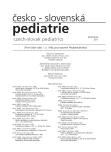The effect of mouth breathing on splanchnocraniums development in childhood
Authors:
J. Lysý 1; J. Jakubíková 2; J. Barkociová 2; B. Suchancová 1; A. Thurzo 1
Authors‘ workplace:
Klinika stomatológie a maxilofaciálnej chirurgie LFUK a OÚSA, Bratislava
prednosta prof. MUDr. V. Javorka, CSc.
1; Detská otorinolaryngologická klinika DFNsP, Bratislava
prednosta prof. MUDr. J. Jakubíková, CSc.
2
Published in:
Čes-slov Pediat 2011; 66 (5): 294-298.
Category:
Case Report
Overview
Mouth breathing is a common symptom accompanying diseases in childhood. If it is persisting chronically, it can influence the growth characteristics of developing splanchnocranium. It is associated with narrow maxilla on skeletal and dentoalveolar level and increased face height as a consequence of posteriorotational growth pattern. In case of early diagnosis, causal therapy and restoration of breathing through the nose an improvement of growth characteristics can develop.
Authors are presenting two cases of patients with typical growth changes accompanying mouth breathing.
Key words:
dentofacial growth, nasal obstruction, mouth breathing, malocclusion
Sources
1. Paraya A, Choakchai M. Choanal atresia. J Med Assoc Thai 2009; 92 (5): 699–706.
2. Bachratý A, Bachratá L, Suchancová B. Čeľustná ortopédia. Uprav. 4. vyd. Univerzita Komenského, 2006. ISBN 80-223-2073-0.
3. Aznar T, Galan AF, Marin I, et al. Dental arch diameters and relationships to oral habits. Angle Orthod 2006 May; 76 (3): 441–445.
4. Vig KW. Nasal obstruction and facial growth: The strength of evidence for clinical assumptions. Am J Orthod Dentofacial Orthop 1998 Jun; 113 (6): 603–611.
5. Warren DW, Mayo R, Zajac DJ, et al. Dyspnea following experimentally induced increased nasal airway resistance. Cleft Palate Craniofac J 1996 May; 33 (3): 231–235.
6. Tourne LP, Schweiger J. Immediate postural responses to total nasal obstruction. Am J Orthod Dentofacial Orthop 1996 Dec; 110 (6): 606–611.
7. Rakosi T, Jonas I. Kieferorthopädie, Diagnostik. Stuttgart: Georg Thieme Verlag, 1989 : 123–145.
8. Harvold EP, Tomer BS, Chierici G. Primate experiments on oral respiration. Am J Orthod 1981; 79 (4): 359–372.
9. McNamara JA. Influence of respiratory pattern on craniofacial growth. Angle Orthod 1981 Oct; 51 (4): 269–300.
10. Gungor AY, Turkkahraman H. Effects of airway problems on maxillary growth: a review. Eur J Dent 2009 Jul; 3 (3): 250–254.
11. De Menezes VA, Leal RB, Pessoa RS, et al. Prevalence and factors related to mouth breathing in school children at the Santo Amaro project-Recife, 2005. Braz J Otorhinolaryngol 2006 May-Jun; 72 (3): 394–399.
12. Fields HW, Warren DW, Black K, et al. Relationship between vertical dentofacial morphology and respiration in adolescents. Am J Orthod Dentofacial Orthop 1991 Feb; 99 (2): 147–154.
13. Linder-Aronson S. Adenoids. Their effect on mode of breathing and nasal airflow and their relationship to characteristics of the facial skeleton and the denition. A biometric, rhino-manometric and cephalometro-radiographic study on children with and without adenoids. Acta Otolaryngol 1970; 265 (Suppl): 1–132.
14. Woodside DG, Linder-Aronson S, Lundstrom A, et al. Mandibular and maxillary growth after changed mode of breathing. Am J Orthod Dentofacial Orthop 1991 Jul; 100 (1): 1–18.
15. Löfstrand-Tideström B, Thilander B, Ahlqvist-Rastad J, et al. Breathing obstruction in relation to craniofacial and dental arch morphology in 4-year-old children. Eur J Orthod 1999 Aug; 21 (4): 323–332.
16. Peltomäki T. The effect of mode of breathing on craniofacial growth-revisited. Eur J Orthod 2007 Oct; 29 (5): 426–429.
17. Příhodová I. Obstrukční spánková apnoe dětského věku. Čes-slov Pediat 2007; 62 (11): 631–637.
Labels
Neonatology Paediatrics General practitioner for children and adolescentsArticle was published in
Czech-Slovak Pediatrics

2011 Issue 5
Most read in this issue
- Thromboembolism events in the newborn child from the point of view of present medicine
- The effect of mouth breathing on splanchnocraniums development in childhood
-
Influence of passive exposure to cigarette smoke on health and development of children in prenatal and postnatal period to 7 years of age.
Results of ELSPAC Study - Quality of life in children with allergic rhinitis
